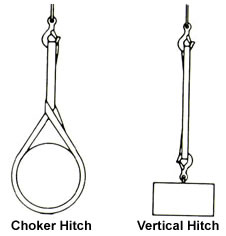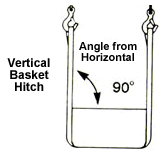Back to Product Category
WIRE
ROPE 2 LEG BRIDLE SLINGS
|
|
HOW
TO ORDER WIRE ROPE SLINGS |
|
| We
have developed the following wire rope sling code system to help you in
ordering these products. |
 |
|
|
 |
|
Order
Online, by Phone, or by E-Mail |
|
|
|
~ Add
items to your online shopping cart ~
Click a Price of the item you wish to purchase. |
|
|
Bridle
Slings |

Rope
Dia.
(in.) |
¹Min.
Sling
Length |

Eye
Hook
Cap.
(tons) |
Rated Capacity* (tons) |

Oblong
Link
Stock
Dia. |
Prices |
 |
 |
 |
3' |
4' |
6' |
8' |

6
x
19 |
1/4 |
1' 3" |
1 |
1.1 |
.91 |
.65 |
1/2 |
|
|
|
|
| 5/16 |
1' 6'' |
1 |
1.7 |
1.4 |
1.0 |
1/2 |
|
|
|
|
| 3/8 |
1' 8" |
1 1/2 |
2.5 |
2.0 |
1.4 |
3/4 |
|
|
|
|
| 7/16 |
1' 10" |
2 |
3.4 |
2.7 |
1.9 |
3/4 |
|
|
|
|
| 1/2 |
2' |
3 |
4.4 |
3.6 |
2.5 |
3/4 |
|
|
|
|
| 9/16 |
2' 2" |
4 1/2 |
5.5 |
4.5 |
3.2 |
1 |
|
|
|
|
| 5/8 |
2' 4" |
4 1/2 |
6.8 |
5.5 |
3.9 |
1 |
|
|
|
|
| 3/4 |
2' 9" |
7 |
9.7 |
7.9 |
5.6 |
1 1/4 |
|
|
|
|
| 7/8 |
3' 3" |
11 |
13 |
11 |
7.6 |
1 1/4 |
- |
|
|
|
| 1 |
3' 6" |
11 |
17 |
14 |
9.8 |
1 1/2 |
- |
|
|
|
| 1 1/8 |
4' |
15 |
21 |
17 |
12 |
1 3/4 |
- |
|
|
|

6
x
37
|
1 1/4 |
4' 6" |
15 |
26 |
21 |
15 |
1 3/4 |
- |
- |
|
|
| 1 3/8 |
5' |
22 |
31 |
25 |
18 |
2 |
- |
- |
|
|
| 1 1/2 |
5' 6" |
22 |
37 |
30 |
21 |
2 1/4 |
- |
- |
|
|
| 1 3/4 |
6' 6" |
30 |
49 |
40 |
28 |
2 3/4 |
Upon
Request |
| 2 |
8' |
37 |
63 |
52 |
37 |
2 3/4 |
Upon
Request |
Length
Tolerances (Single Part Wire Rope Slings): Standard length tolerance
is plus or minus two rope diameters,
OR plus or minus 0.5% of the sling length, whichever is greater. The legs
of bridle slings, or matched slings are
normally held to within one rope diameter. |
|
|
|
|
|
|
|
| Other
fittings and latches are available upon request. |
|
|
|
|
|
|
|
|
|
| ¹ Minimum
length based on thimbled eye and eye hook. |
|
|
|
|
|
|
|
|
| * |
 |
|
|
|
|
Do
not exceed rated capacities. Sling capacity decreases as the angle from
horizontal decreases.
Slings should not be used at angles of less than 30°. Refer to the Effect
of Angle chart below. |
|
|
|
|
|
|
|
|
|
|
|
|
|
| EFFECT
OF SLING ANGLE |
|
|
|
|
|
|
|
|
|
Using
slings at an angle can become deadly if that angle is not taken into
consideration when selecting the sling to
be used. The tension on each leg of the sling is increased as the angle
of lift, from horizontal, decreases. It is most
desirable for a sling to have a larger angle of lift, approaching 90°.
Lifts with angles of less than 30° from horizontal
are not recommended. If you can measure the angle of lift or the length
and height of the sling as rigged, you can
determine the properly rated sling for your lift. The Increased Tension
method provides the increased tension as a
function of the sling angle. Alternatively, the sling Reduced Capacity method
may be used to determine reduced lift
capacity for any angle. |
|
|
|
|
|
|
|
|
|
INCREASED
TENSION
Determine capacity
of sling needed |
 |
REDUCED
CAPACITY
Calculate rating of each sling
rigged at this angle |
|
|
|
|
|
| 1.
Determine the load weight (LW). |
1.
Calculate the reduction factor (RF). |
|
|
|
|
a.
Using the angle from horizontal,
read across the Angle Chart to
the corresponding number of the
Reduction Factor column. |
| 2.
Calculate the Tension Factor [TF]. |
|
|
a.
Determine the sling angle as mea-
sured from the horizontal, and the
corresponding tension factor (TF)
from the effect of angle chart. |
|
|
|
-OR- |
|
|
b.
Divide sling height* (H) by sling
length* (L). |
|
-OR- |
|
|
|
b.
Length* (L) divided by height*
(H) |
|
|
|
|
|
2.
Reduction factor (RF) x the sling’s
rated capacity for the type hitch that
will be used = sling’s reduced rating. |
|
|
|
|
|
|
|
|
|
|
|
|
3.
Determine the share of the load
applied to each sling leg (LW). |
|
|
 |
|
|
|
|
|
|
|
|
|
|
|
|
|
|
4.
Multiply (LW) by (TF) to determine
the sling leg tension. The capacity of
the selected sling or sling leg must
meet the calculated tension value. |
|
|
*Measured
from a common horizontal
plane to the hoisting hook. |
|
|
|
|
|
|
|
|
|
|
|
|
*Measured
from a common horizontal plane
to the hoisting hook. |
|
|
|
|
|
|
|
|
|
|
|
|
|
|
|
|
 |
|
Effect
of Angle Chart |
|
 |
|
|
Tension
Factor (TF) |
Angle From
Horizontal |
Reduction
Factor (RF) |
| 1.000 |
90º |
1.000 |
| 1.004 |
85º |
0.996 |
| 1.015 |
80º |
0.985 |
| 1.035 |
75º |
0.966 |
| 1.064 |
70º |
0.940 |
| 1.104 |
65º |
0.906 |
| 1.155 |
60º |
0.866 |
| 1.221 |
55º |
0.819 |
| 1.305 |
50º |
0.766 |
| 1.414 |
45º |
0.707 |
| 1.555 |
40º |
0.643 |
| 1.742 |
35º |
0.574 |
| 2.000 |
30º |
0.500 |
|
|
|
|
|
|
|
|
|
Example: |
|
|
|
Vertical
Choker rating of each sling:
6,000 lbs.
Measured Length (L) = 6 ft.
Measured Height (H) = 4 ft.
Reduction Factor (RF) = 4 (H) ÷ 6 (L) = .667 |
|
|
|
|
| Example: |
|
|
|
Load
weight = 1,000 lbs.
Rigging - 2 slings in vertical hitch
Lifting Weight (LW) per sling = 500 lbs.
Measured Length (L) = 10 ft.
Measured Height (H) = 5 ft.
Tension Factor (TF) = 10 (L) ÷ 5 (H) = 2.0
Minimum Vertical Rated Capacity required
for this lift = 500 (LW) x 2.0 (TF) = 1000 lbs.
per sling |
|
Sling
capacity decreases as the angle
from horizontal decreases. Sling angles
of less than 30° are not recommended. |
|
|
Reduced
sling rating in this configuration
= .667 |
|
(RF)
x 6,000 lbs. = 4,000 lbs. of lifting
capacity per sling |
|
|
|
|
|
|
|
Wire Rope Bridle Slings,
2, 3, & 4 Leg, Wire Rope Sling, Lift-All, Lifting Slings, 2-Leg Bridle
Sling, Prices include
Thimbled Eyes and Eye Hooks, 3-Leg Bridle Sling, and 4-Leg Bridle Sling
from your source for material handling
equipment. |
Back to Product Category
|



